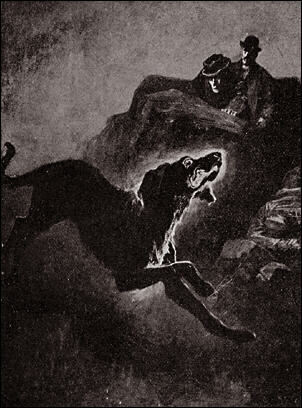A Scion Society of The Baker Street Irregulars

The 17 Steps: The Hound of The Baskervilles
Seventeen thoughts for further ponderance of the case at hand – The Hound of The Baskervilles (HOUN)

THE MOST FAMOUS SKULL IN LONDON?
“This is my friend Dr. Watson,” Holmes introduces Mortimer to Watson.
“Glad to meet you, sir,” Mortimer replies, “I have heard your name mentioned in connection with that of your friend. You interest me very much, Mr. Holmes. I had hardly expected so dolichocephalic a skull or such well-marked supra-orbital development. Would you have any objection to my running my finger along your parietal fissure? A cast of your skull, sir, until the original is available, would be an ornament to any anthropological museum. It is not my intention to be fulsome, but I confess that I covet your skull.”
From the above exchange, we might infer that Mortimer has heard of Holmes via reputation only, not from Watson’s writings. Given what Mortimer didn’t expect about Holmes’s skull, what sort of skull (and what sort of man) was he expecting to find in Sherlock Holmes?
AN AUDIENCE WITH HIS HOLINESS
“I had observed some newspaper comment at the time, but I was exceedingly preoccupied by that little affair of the Vatican cameos, and in my anxiety to oblige the Pope I lost touch with several interesting English cases.”
If Sherlock Holmes were investigating a mystery involving Vatican property, would he have gotten an audience with the Pope? Or is his “anxiety to oblige” based on a request relayed through lesser church officials?
AND ONE WHOLE EVENING THEY JUST SPOKE OF EARS
“Sir Charles was a retiring man, but the chance of his illness brought us together, and a community of interests in science kept us so. He had brought back much scientific information from South Africa, and many a charming evening we have spent together discussing the comparative anatomy of the Bushman and the Hottentot.”
Surely Dr. Mortimer is speaking figuratively about those anatomy discussions, isn’t he? The Bushman and Hottentot are surely not so different to need more than a relatively brief discussion between a medical man and a gold prospector, would it? How did Sir Charles gain all that anatomical knowledge? Consorting with the ladies, or something much more dire?
A FULL DAY OF CLUBBING
“I therefore spent the day at my club and did not return to Baker Street until evening. It was nearly nine o’clock when I found myself in the sitting-room once more.”
Watson apparently spends about ten hours at his club. What would he have been doing there all that time? Lunch, supper, billiards, magazines, conversation, and what else?
SURE, I’LL CHANGE 5 POUNDS INTO 56 FOR YOU!
“And I should be glad to have change of this five-pound note.”
“Here are twenty-three shillings.”
“There are ten shillings over in case of emergencies.”Okay, twenty shillings to a pound, and Holmes hands out fifty-six shillings … what other change might Holmes have gotten, that he didn’t just throw in the other four shillings?
AND NOW, THE MAN WHO LOVES ART FOR ART’S SAKE …
Holmes announces, “we will drop into one of the Bond Street picture galleries and fill in the time until we are due at the hotel.”
It’s his choice, but then Watson reports: “He would talk of nothing but art, of which he had the crudest ideas, from our leaving the gallery until we found ourselves at the Northumberland Hotel.”
Just how does Watson mean that? Was Watson’s sense of art more developed than this descendant of Vernets, or would Holmes’s “crudest ideas” have sounded equally crude to any listener?
THE HOUND OF THE RAILWAY CARRIAGE
“The journey was a swift and pleasant one, and I spent it in making the more intimate acquaintance of my two companions and in playing with Dr. Mortimer’s spaniel.”
How does one play with a spaniel in the limited confines of a railway carriage? “Tug o’ war” is all that comes to mind — what personal item might Watson have sacrificed to the dog’s worrying, if that was the game?
THAT SAUCY BERYL STAPLETON
“‘It certainly did cross my mind that it might be a little dull–less for you, perhaps, than for your sister.’
“‘No, no, I am never dull,’ said she quickly.”
Was Beryl betraying a bit of her true character here? Could a true and faithful wife have led Sir Henry on as thoroughly as she did, “light in her eyes” and all?
AND THE WACKY BARONET OF BASKERVILLE HALL
“By thunder, Watson, I am going out to take that man!”
After making this bold statement, Sir Henry sets off to catch a murderer armed with only a riding crop. Was he counting upon Watson and his revolver when he first made that statement, was Henry just that good a man-handler, or was he just a bit daft? What evidence do we have one way or the other?
WATSON, THE RUNNER
Watson seems to be quite the track star in this tale, as evidenced by two examples:
“Shall I run on and stop them?”
“We were both swift runners and in fairly good training, but we soon found that we had no chance of overtaking him.”
In the first he seems to think he can run better than Holmes, and in the second he mentions training. Had Watson taken up some sort of running as therapy for his old wound? How common was running as an avocation of Victorian health afficionados?
THE LADY’S MAN AT WORK
“At the moment I was simply conscious that I was in the presence of a very handsome woman, and that she was asking me the reasons for my visit. I had not quite understood until that instant how delicate my mission was.”
What about the two statements in the first sentence made Watson understand that his mission was delicate in the second? Would Watson have been more heavy-handed in his dealings were he not confronted with an attractive woman? Or was the sudden delicacy merely the result of Watson realizing that this was a woman he might have some non-investigatory interest in? (And how long did it take him to come to his second impression of the woman — after he checked out the status of her divorce proceedings, perhaps?)
I FOUGHT THE LAW, AND THE LAW WON
“The County Constabulary is in a scandalous state, sir, and it has not afforded me the protection to which I am entitled. The case of Frankland v. Regina will bring the matter before the attention of the public. . . . They have treated me shamefully–shamefully. When the facts come out in Frankland v. Regina I venture to think that a thrill of indignation will run through the country.”
In perhaps his most foolish lawsuit ever, old Frankland the crank goes up against local law enforcement. What was he hoping to gain by it? Didn’t he have to be suing for some particular thing? Would it have been money, police patrols by his home, an apology, or what?
AND HIS HAWAIIAN SHIRT WAS THE BEST PART
Watson describes Holmes: “He was thin and worn, but clear and alert, his keen face bronzed by the sun and roughened by the wind. In his tweed suit and cloth cap he looked like any other tourist upon the moor.”
Was Dartmoor much of a tourist attraction in the Victorian era? And was October a good time for getting a tan there?
THE MASTER PREPARES FOR HIS CLASS
“I shall soon be in the position of being able to put into a single connected narrative one of the most singular and sensational crimes of modern times. Students of criminology will remember the analogous incidents in Grodno, in Little Russia, in the year ’66, and of course there are the Anderson murders in North Carolina, but this case possesses some features which are entirely its own.”
What about the incidents in Godno and the Anderson murders could have possible come close to the strange series of events we find in the tale of the Hound? Is Holmes speaking of a narrative that he actually planned to write?
LESTRADE, THE PANTS POCKET PISTOLERO
In one of my favorite quotes from this tale, our favorite Scotland Yard man says, “As long as I have my trousers I have a hip-pocket, and as long as I have my hip-pocket I have something in it.”
Was that safe? How about comfortable? Were pants pockets bigger and roomier back then than the standard trouser pocket now? Was Lestrade carrying a smaller pistol?
THE ISLE OF THE HOUND
“Many traces we found of him in the bog-girt island where he had hid his savage ally.”
Okay, how did Stapleton get a starving giant of a dog in and out of his island hideout without the beast falling into the bog himself? How did he have such control over such a beast?
A FAST FRIENDSHIP, A SLOW BOAT TO EVERYWHERE
Of Sir Henry, Watson writes, “But the shock of the night’s adventures had shattered his nerves, and before morning he lay delirious in a high fever under the care of Dr. Mortimer. The two of them were destined to travel together round the world before Sir Henry had become once more the hale, hearty man that he had been before he became master of that ill-omened estate.”
Brain fever, caused by a dog attack, striking a man who wanted to capture a killer with only a riding crop seems odd, but even odder is that round-the-world journey with a man he’s only known a month. How did the Canadian farmer and the skull-enthusiast hit it off so well so quickly? What’s the shortest amount of time the two could be gone? Wouldn’t Mortimer’s practice and patients (not to mention his wife) be a bit put out?

The Seventeen Steps originally appeared on the Hounds of the Internet e-list from September 2000 to October 2001 and later on the Sherlock Peoria blog.
Brad Keefauver, the 41st Garrideb, is the author of The Elementary Methods of Sherlock Holmes, Sherlock and the Ladies, and The Armchair Baskerville Tour. Former publisher of The Holmes & Watson Report, The Dangling Prussian, and a whole lot of obscure, collectable little things on our boy Sherlock. Keefauver is a member of the Baker Street Irregulars and the Adventuresses of Sherlock Holmes.

Sorry, comments are closed for this post.